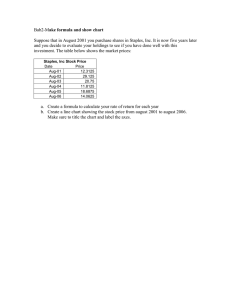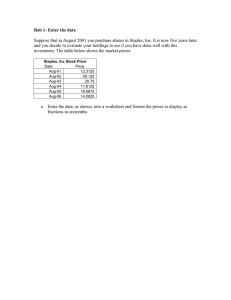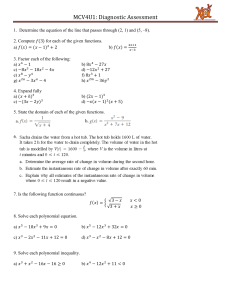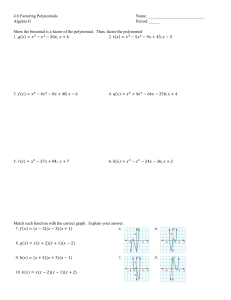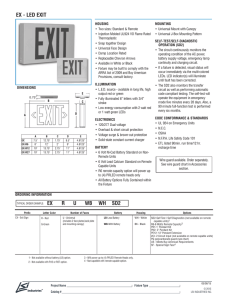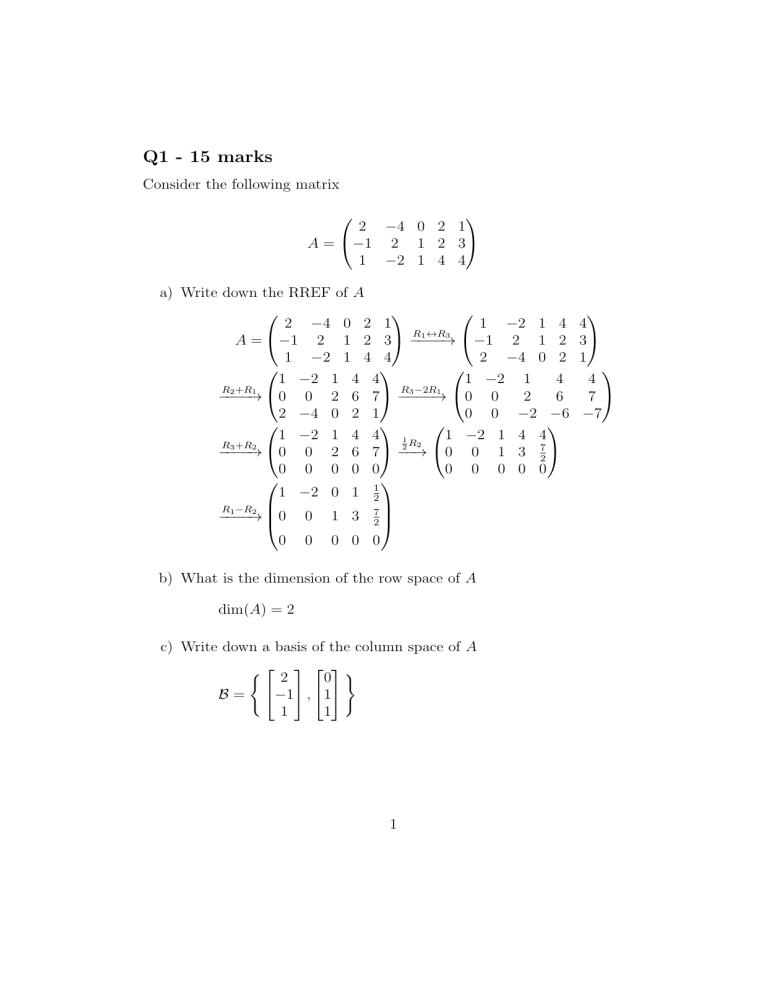
Q1 - 15 marks Consider the following matrix 2 −4 0 2 1 A = −1 2 1 2 3 1 −2 1 4 4 a) Write down the RREF of A 2 −4 0 2 1 1 −2 1 4 R1 ↔R3 A = −1 2 1 2 3 −−−−→ −1 2 1 2 1 −2 1 4 4 2 −4 0 2 1 −2 1 4 4 1 −2 1 4 R +R1 R3 −2R1 0 0 2 6 7 − 2 6 −−2−−→ −−−→ 0 0 2 −4 0 2 1 0 0 −2 −6 1 −2 1 4 4 1 −2 1 4 4 1 R 2 R +R2 0 0 1 3 7 0 0 2 6 7 −2−→ −−3−−→ 2 0 0 0 0 0 0 0 0 0 0 1 −2 0 1 21 R −R2 0 0 1 3 7 −−1−−→ 2 0 0 0 0 0 b) What is the dimension of the row space of A dim(A) = 2 c) Write down a basis of the column space of A ( 2 0 ) B = −1 , 1 1 1 1 4 3 1 4 7 −7 d) What is the nullity of A. Write down a basis of the nullspace A? nullity(A) = 3 From a): 1 −2 0 1 21 | 0 0 0 1 3 7 | 0 2 0 0 0 0 0 | 0 + x4 + 12 x5 = 0 x1 − 2x2 x3 + 3x4 + 72 x5 = 0 x1 = 2s − t − 12 u x2 = s x3 = −3t + 72 u x4 = t x5 = u 1 2 −1 −2 1 0 0 7 ⃗x = s 0 + t −3 + u 2 0 1 0 0 0 1 1 2 −1 − 2 1 0 0 7 ∴ B = 0 , −3 , 2 0 1 0 0 1 0 2 Q2 - 20 marks The aim of this question will be to produce matrices with specificed eigen values which are not just triangular! Let p(x) be the polynomial p(x) = xn + an−1 xn−1 + · · · + a1 x + a0 and define the companion matrix to the polynomial as −an−1 −an−2 · · · −a1 −a0 1 0 ··· 0 0 .. .. .. C(p) = 0 . 1 . . 0 0 ··· 0 0 0 0 ··· 1 0 a) Write down the matrix C(p) of the polynomial p(x) = x3 − 4x2 + 5x − 2 4 −5 2 C(p) = 1 0 0 0 1 0 b) Find the characteristic polynomial of the matrix C(p) which you wrote in the previous step 4 − λ −5 2 −λ 0 C(p) − λI = 1 0 1 −λ det(C(p) − λI = 2 1 −λ 4 − λ −5 −λ 0 1 1 −λ = 2(1) − λ[(4 − λ)(−λ) − (−5)] = 2 − λ(−4λ + λ2 + 5) = 2 + 4λ2 − λ3 − 5λ = −λ3 + 4λ2 − 5λ + 2 = 0 3 4 c) Show that 2 is an eigenvector of C(p) with eigenvalue 2 1 4 Let ⃗x be 2, then 1 4 −5 2 4 16 − 10 + 2 8 2 = 4 C(p)⃗x = 1 0 0 = 4 0 1 0 1 2 2 4 8 λ⃗x = 2 2 = 4 1 2 ∴ C(p)⃗x = λ⃗x 4 ∴ ⃗x = 2 is an eigenvector of C(p) with eigenvalue λ = 2 1 d) Find the matrix C(p) associated to the polynomial p(x) = x3 + ax2 + bx + c −a −b −c 0 0 C(p) = 1 0 1 0 4 e) Determine the characteristic polynomial of the matrix C(p) from the previous step −a − λ −b −c −λ 0 C(p) − λI = 1 0 1 −λ det(C(p) − λI) = −1 −a − λ −c −a − λ −b −λ 1 0 1 −λ = −1[(−a − λ)(0) − (−c)(1)] − λ[(−a − λ)(−λ) − (−b)(1)] = −1(c) − λ(aλ + λ2 + b) = −c − aλ2 − λ3 − bλ = −λ3 − aλ2 − bλ − c = 0 5 f) Show 2 that if λ is an eigenvalue of the companion matrix C(p), then λ λ is an eigenvector of C(p) corresponding to λ 1 Eλ = Nul(C(p) − λI) −a − λ −b −c | 0 −a − λ −b −c | 0 R ↔R3 0 −λ 0 | 0 −−2−−→ 1 −λ | 0 = 1 0 1 −λ | 0 1 −λ 0 | 0 1 −λ 0 | 0 R1 ↔R3 0 1 −λ | 0 −−−−→ −a − λ −b −c | 0 1 0 −λ2 | 0 R3 +bR2 R +λR2 0 1 −λ | 0 −−1−−−→ −a − λ 0 −c − bλ | 0 1 0 −λ2 | 0 R3 +(a+λ)R1 −λ | 0 −−−−−−−→ 0 1 3 2 0 0 −λ − aλ − bλ − c | 0 From the characteristic polynomial: λ3 = −aλ2 − bλ − c 1 0 −λ2 | 0 −λ | 0 ∴ 0 1 2 2 0 0 −(−aλ − bλ − c) − aλ − bλ − c | 0 1 0 −λ2 | 0 x1 − λ2 x3 = 0 ∴ 0 1 −λ | 0 ⇒ x2 − λx3 = 0 0 0 0 | 0 x1 = λ 2 s x2 = λs ⇒ 2 λ ⃗x = s λ 1 x3 = s 2 λ ∴ BEλ = λ 1 2 λ ⇒ λ is an eigenvector of C(p) corresponding to λ 1 6 g) Construct a non-triangular 3 × 3 matrix of eigenvalues -2, 1, 3 using companion matrices. Briefly justify your answer. From f) 2 λ Eλ = λ 1 Thus, λ = −2, 1, 3 4 1 BE−2 = −2 BE1 = 1 1 1 4 1 9 ∴ P = −2 1 3 1 1 1 4 1 9 | 1 0 0 [ P | I ] = −2 1 3 | 0 1 0 1 1 1 | 0 0 1 3 0 8 | 1 0 −1 R1 −R3 R −R3 −3 0 2 | 0 1 −1 −−2−−→ 1 1 1 | 0 0 1 3 0 8 | 1 0 −1 R +R1 0 0 10 | 1 1 −2 −−2−−→ 1 1 1 | 0 0 1 3 0 8 | 1 0 −1 1 R2 1 1 −2 −10 −−→ 0 0 1 | 10 10 10 1 1 1 | 0 0 1 2 −8 6 3 0 0 | 10 10 10 R1 −8R2 1 1 −2 −−−−→ 0 0 1 | 10 10 10 1 1 1 | 0 0 1 7 BE3 9 = 3 1 2 1 0 0 | 30 −−−−→ 1 1 1 | 0 3 0 0 1 | 30 2 1 0 0 | 30 R −R1 0 1 1 | −2 −−2−−→ 30 3 0 0 1 | 30 2 1 0 0 | 30 R −R3 0 1 0 | −5 −−2−−→ 30 3 0 0 1 | 30 1 −4 1 0 0 | 15 15 1 −1 → − 6 0 1 0 | 6 1 1 0 0 1 | 10 10 1 4 1 − 15 15 5 −1 1 1 1 P − 6 6 1 1 1 −5 10 10 R2 ↔R3 1 R 3 1 A = P DP −1 4 1 9 −2 = −2 1 3 0 1 1 1 0 1 −8 1 27 15 1 4 1 9 = − 6 −2 1 3 1 10 2 5 −6 A = 1 0 0 0 1 0 −8 30 6 30 1 0 3 30 −6 30 −8 30 8 30 3 30 6 30 24 30 −6 30 −8 30 5 30 3 30 6 30 1 5 1 −6 30 1 −1 5 1 4 1 − 15 15 5 0 0 1 1 1 0 − 1 6 6 0 3 1 1 1 − 10 5 10 4 1 − 15 5 1 1 6 1 1 −5 10 8 Q3 - 20 marks Consider the matrix 0 0 4 2 0 0 0 −2 0 0 0 −2 2 0 A= 0 0 a) Find matrices P and D (with D diagonal) so that A = P DP −1 CA (λ) = (λ − 2)2 (λ + 2)2 λ = 2, −2 For λ = 2, 0 0 4 2−2 0 0 0 −2 − 2 0 0 0 −2 − 2 0 4 0 0 −4 0 0 −4 0 0 0 4 | 0 0 0 0 | E2 = Nul(A − 2I) = 0 0 −4 0 | 0 0 0 −4 | 2−2 0 A − 2I = 0 0 0 0 0 0 = 0 0 0 0 1 R 4 1 R1 ↔R2 − 41 R3 − 14 R4 0 0 −−−−→ 0 0 0 0 0 0 0 0 1 0 0 1 0 1 | | | | 0 0 R3 ↔R1 0 −R1 0 −R−4− −→ 0 0 0 0 x1 = free x1 = s x2 = free x2 = t x3 = 0 x3 = 0 x4 = 0 x4 = 0 9 0 0 0 0 ⇒ 1 0 | 0 0 1 | 0 0 0 | 0 0 0 | 0 1 0 0 1 ⃗x = s 0 + t 0 0 0 0 0 0 0 ∴ BE2 0 1 0 1 = , 0 0 0 0 For λ = −2, 4 0 A + 2I = 0 0 0 4 0 0 0 0 0 0 4 0 0 0 E−2 4 0 = N ul(A + 2I) = 0 0 x1 + x4 = 0 0 4 0 0 0 0 0 0 1 0 Thus, P = 0 0 0 1 0 0 | | | | x1 = −t x2 = 0 x2 = 0 x3 = free x3 = s x4 = free x4 = t 0 −1 0 , 0 ∴ BE−2 = 1 0 0 1 4 0 0 0 0 −1 2 0 0 0 and D = 0 1 0 0 1 0 10 ⇒ 1 0 0 1 0 41 R1 1 R 0 4 2 0 1 0 0 −−→ 0 0 0 0 0 0 0 0 0 0 0 −1 0 0 ⃗x = s 1 + t 0 0 1 0 0 0 2 0 0 0 −2 0 0 0 −2 | | | | 0 0 0 0 b) For each positive integer n, write down a formula for An ∀n ∈ Z+ , An = (P DP −1 )n −1 −1 = (P D P )( P D P ) . . . ( P DP −1 ) = P Dn P −1 n 1 0 0 −1 2 0 0 0 1 0 1 0 0 0 2 n 0 0 0 = 0 0 1 0 0 0 (−2)n 0 0 0 0 0 1 0 0 0 (−2)n 0 11 0 1 0 0 0 0 1 0 1 0 0 1 Q4 - 20 marks A study of pine nuts in the American southwest from 1940 to 1947 hypothesized that nut production followed a Markov chain. The data suggested that if one year’s crop was good, then the probabilities that the following year’s crop would be good, fair, or poor were 0.08, 0.07, 0.85 respectively; if one year’s crop was fair, then the probabilities that the following year’s crop would be good, fair, or poor were 0.09, 0.11, and 0.80, respectively; if one year’s crop was poor, then the probabilities that the following year’s crop would be good, fair, or poor were 0.11, 0.05, 0.84 respectively. a) Write down the transition matrix for this Markov process 0.08 0.09 0.11 A = 0.07 0.11 0.05 0.85 0.80 0.84 b) If the pine cut crop was good in 1940, find the probabilities of a good crop in the years 1941 through 1945 1 0.08 0.09 0.11 1 0.08 1941: A 0 = 0.07 0.11 0.05 0 = 0.07 ⇒ 0.08 0 0.85 0.80 0.84 0 0.85 1 1 0.08 2 1942: A 0 = AA 0 = A 0.07 0 0 0.85 0.08 0.09 0.11 0.08 0.1062 = 0.07 0.11 0.05 0.07 = 0.0558 0.85 0.80 0.84 0.85 0.838 ⇒ 0.1062 1 0.1062 1 1943: A3 0 = AA2 0 = A 0.0558 0.838 0 0 0.08 0.09 0.11 0.1062 0.105698 = 0.07 0.11 0.05 0.0558 = 0.055472 0.85 0.80 0.84 0.838 0.83883 ⇒ 0.105698 12 1 1 0.105698 1944: A4 0 = AA3 0 = A 0.055472 0 0 0.83883 0.08 0.09 0.11 0.105698 0.10571962 = 0.07 0.11 0.05 0.055472 = 0.05544228 0.85 0.80 0.84 0.83883 0.8388381 ⇒ 0.10571962 1 1 0.10571962 1945: A5 0 = AA4 0 = A 0.05544228 0 0 0.8388381 0.08 0.09 0.11 0.10571962 = 0.07 0.11 0.05 0.05544228 0.85 0.80 0.84 0.8388381 0.1057195658 = 0.0554409292 ⇒ 0.10571962 0.838839505 c) In the long run, what proportion of the crops will be good, fair, and poor? Since the steady state vector is the eigenvector corresponding to λ = 1, 0.08 − 1 0.09 0.11 | 0 0.11 − 1 0.05 | 0 E1 = Nul(A − 1I) = 0.07 0.85 0.80 0.84 − 1 | 0 −0.92 0.09 0.11 | 0 = 0.07 −0.89 0.05 | 0 0.85 0.80 −0.16 | 0 9 11 − | 0 1 − 1 92 92 R −0.92 1 −−−−→ 0.07 −0.89 0.05 | 0 0.85 0.80 −0.16 | 0 9 1 − 92 − 11 | 0 92 R2 −0.07R1 R3 −0.85R1 325 537 −−−−−−→ 0 − 368 9200 | 0 325 537 0 368 − 9200 | 0 13 11 − 92 | 0 R +R1 0 − 325 537 | 0 −−3−−→ 368 9200 0 0 0 | 0 9 1 − 92 − 11 | 0 92 − 368 R 325 2 537 −−−−→ 0 1 − 8125 | 0 0 0 0 | 0 1024 1 0 − 8125 | 0 9 R2 R1 + 92 537 0 1 − | 0 −−−− −→ 8125 0 0 0 | 0 x1 1 − x2 − a 9 − 92 1024 x 8125 3 537 x 8125 3 x2 = 1024 s 8125 537 s 8125 x3 = s x1 = =0 =0 1024 8125 ⇒ 537 ⃗x = s 8125 1 537 8125 1024 +a +a=1⇒a= 8125 8125 9686 1024 512 8125 4838 537 537 ⇒ ⃗v = a 8125 = 9686 8125 1 9686 512 ∴ In the long run, 4838 crops will be good, 8125 crops will be poor 9686 14 537 9686 crops will be fair, and
